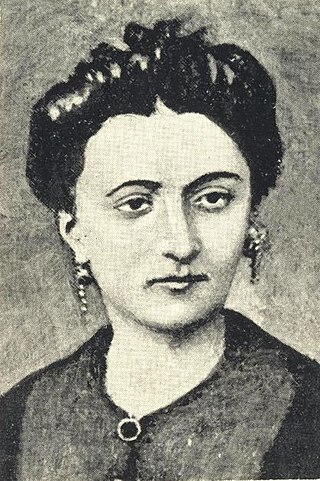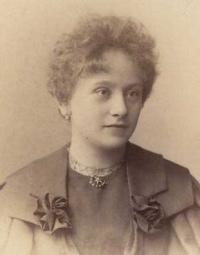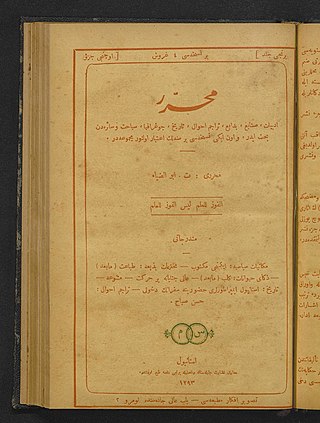Iranian Armenians, also known as Persian Armenians, are Iranians of Armenian ethnicity who may speak Armenian as their first language. Estimates of their number in Iran range from 70,000 to 500,000. Areas with a high concentration of them include Tabriz, Tehran, Salmas and New Julfa, Isfahan.
Roughly speaking, the prose of the Ottoman Empire can be divided along the lines of two broad periods: early Ottoman prose, written prior to the 19th century CE and exclusively nonfictional in nature; and later Ottoman prose, which extended from the mid-19th century Tanzimat period of reform to the final fall of the Ottoman Empire in 1922, and in which prose fiction was first introduced.

An actor or actress is a person who portrays a character in a production. The actor performs "in the flesh" in the traditional medium of the theatre or in modern media such as film, radio, and television. The analogous Greek term is ὑποκριτής (hupokritḗs), literally "one who answers". The actor's interpretation of a role—the art of acting—pertains to the role played, whether based on a real person or fictional character. This can also be considered an "actor's role", which was called this due to scrolls being used in the theaters. Interpretation occurs even when the actor is "playing themselves", as in some forms of experimental performance art.
The Armenian Theater dates to before Roman times and is one of the oldest Eurasian theatrical traditions. Alongside Greek and Roman theatres, it stands as one of the world's most ancient theatres. The ancient and beloved form of theatrical art is lyrical (profound) drama, which exerted its influence on the folklore of the Near East, Balkan, and Apennine peoples. Within this cultural context, Armenian folk and mystical drama, characterized by its dance elements, also took shape. Although the ancient theatre system hasn't been preserved, it has left its linguistic marks.

Vahram Papazian or Papazyan, was a Soviet actor who was an ethnic Armenian, mostly known for his Shakespearean roles. Vahram did plays in Constantinople, Tiflis, Baku Armenian theaters, Moscow's Maly Theatre and in France, Italy, Austria, Spain, and Belgium. Papazian began his career in 1908, where he was regarded as one of the best Armenian actors at the time. Before his death he was known as the leading star in the Sundukyan Academic Theatre. The Council of National Literature's wrote that 'Vahram Papazian's Othello dominated the Armenian stage for more than half a century'.
Papazyan is a surname of Armenian origin.

Afife Jale was a Turkish stage actress, best known as the first Muslim theatre actress in Turkey.
The Gedikpaşa Tiyatrosu, also known as the Ottoman Theater and Vartovian Theatre, was an Ottoman theatre established in Istanbul in 1866 and active until 1884. It was the first theatre in the Ottoman Turkey where plays were performed by Turkish actors, whereas previous theatres in the Ottoman Empire had only employed Western travelling theatre troupes or non-Muslim Ottoman people such as Armenians.

Arousyak Papazian was an Ottoman Armenian actress. She is counted as the first professional female actor in the Ottoman Empire and thereby the Middle East.
Azniv Hrachia (1853–1920) was an Ottoman Armenian actress and director.
Maryam Goumbassian was an Ottoman Armenian actress. She belonged to the very first group of actresses in the Ottoman Empire, having debuted in 1862. Prior to her career on stage, she had been a governess. She retired in 1884.

Mihri Müşfik Hanım was an Abkhazian princess and painter who became one of the first and most renowned female painters in Turkey. She was recognized especially for her portraits, including popular figures Mustafa Kemal Atatürk and Pope Benedict XV.

The Ottoman journal Muharrir was published in Istanbul in 8 issues from 1876 to 1878. The editor was Ebüzziya Tevfik (1849-1913), a member of the Young Ottomans to which also the journalists and authors İbrahim Şinasi, Namık Kemal and Ziya Pasha belonged. Ebüzziya published other political newspapers İbret (1872), Hadika (1872) and Sirac (1873) as well as literary journals, including Cüzdan and Mecmua-i Ebüzziya (1880-1912).

The Syunik rebellion of 1722–1730 began as a rebellion of the Armenians of the region of Syunik in Iranian Armenia against Safavid rule and local Muslim tribes and rulers. Under the leadership of Davit Bek, an Armenian soldier from Georgia, the Armenian lords (meliks) of Syunik were united and an independent Armenian principality was established. From 1725, the Armenian principality of Syunik resisted the Ottoman Empire's attempts to occupy the region. After making initial gains and occupying a significant part of the province, the Ottomans were defeated at the Battle of Halidzor on 26 February 1727. After this victory, Davit Bek's forces completely drove the Ottomans out of Syunik, and he was recognized by the Safavid shah Tahmasp II as ruler of Ghapan. After his death in mid-1728, Davit Bek was succeeded by one of his commanders, Mkhitar Sparapet. In a renewed assault, the Ottomans captured and destroyed Halidzor in early 1729, forcing Mkhitar to flee. Although Mkhitar continued to resist the Ottomans and won some victories, he was killed by a group of Armenian villagers in Khndzoresk. Left leaderless, the Armenian forces dispersed, and the Ottomans occupied Syunik, although some Armenians continued to resist from impregnable mountainous areas. The rebellion occurred at the same time as, and occasionally directly cooperated with, an Armenian rebellion in the neighboring region of Karabagh.
Kınar Sıvacıyan, best known as Kınar Hanım, was a Turkish stage actress of Armenian descent.
Hayriye-Melech Xhundj was a Circassian writer and teacher. She is considered one of the first Circassian female writers.
Diken was a weekly satirical magazine which was published in the period 1918–1920 in Istanbul, Ottoman Empire. It was one of the publications which were founded by Sedat Simavi, a well-known Turkish journalist. The magazine was one of the first Ottoman satirical publications which featured color cartoons.
Eurydice was one of the Greek language women's magazines published in Istanbul, Ottoman Empire. It featured women-related articles and also, articles on Greek Orthodox identity and Greek nationalism. The magazine was in circulation between 1870 and 1873.
Mehâsin was a monthly women's magazine which was published in the Ottoman Empire between 1908 and 1909. It was one of the publications started in the aftermath of the Young Turk Revolution and was subtitled as Hanımlara Mahsus. It is known for being the first color women's magazine in the Empire.






